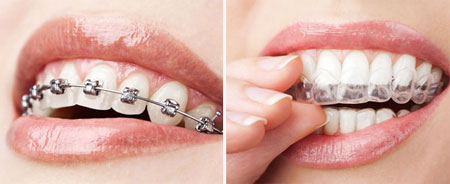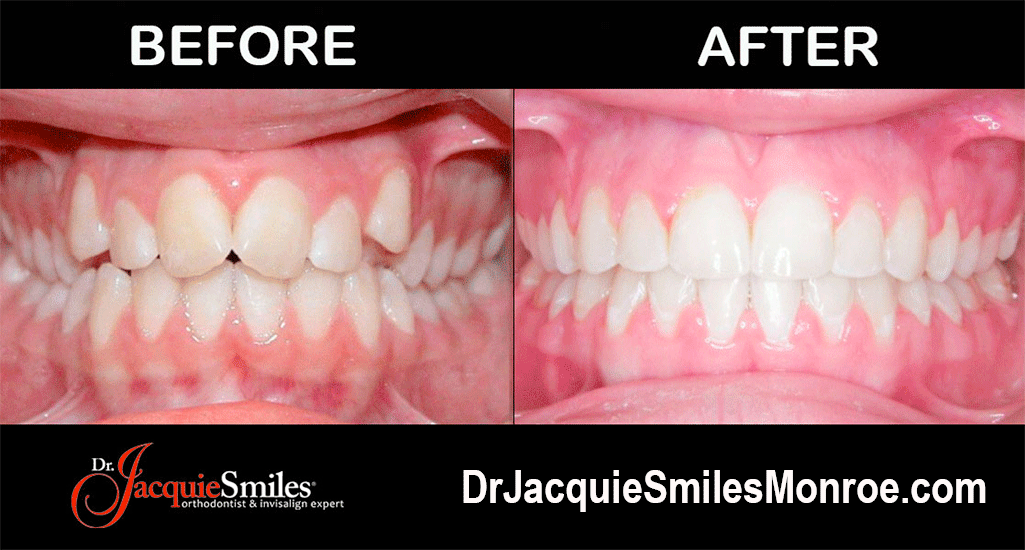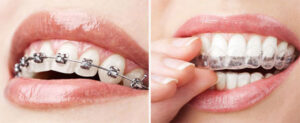
Invisalign and braces both work to correct issues with the alignment and spacing of your teeth. If you are interested in straightening your smile, it’s important to understand how these orthodontic treatments compare in terms of price, aesthetics, comfort, effectiveness, speed, and more.
Please call Dr. Jacquie Smiles at 845-782-4288 or fill out the contact form to receive more information
Price
The cost of orthodontic treatments varies based on a variety of factors. On average, braces cost about $3,000–$7,000 in the United States. Invisalign may be comparable or slightly higher than braces. The duration of your treatment and the complexity of your dental concerns also play a role in determining the cost of your treatment.
Some dental insurance plans may cover a certain percentage of orthodontic treatments, especially for children and teens. Braces are somewhat more likely to be covered than Invisalign.
Many dentists and orthodontists offer financing and flexible payment plans to make teeth straightening treatments more affordable. You can also consider third-party healthcare financing options.
Aesthetics
Braces usually consist of small brackets that are attached to a wire and fitted with bands. The brackets may be made out of metal, ceramic, plaster, or other materials. They may be clear, silver, the color of your teeth, or a variety of other colors.
Many people, especially adults, opt for Invisalign because of its natural aesthetic appearance. Plastic aligners like Invisalign look like clear retainers and are custom-made to fit your mouth.
Comfort
Research suggests that people with traditional braces experience more pain and discomfort than those using Invisalign, especially in the early weeks of treatment and each time an orthodontist tightens them.7
Clear aligners like Invisalign may also take some time to get used to. Patients may have excessive salivation and speak with a lisp for the first few days after beginning treatment.
Braces may also be uncomfortable when metal scrapes or pushes up against the inside of your mouth. Invisalign has a smoother, softer feel.

Time for Straightening
Invisalign and braces are both approved by the US Food and Drug Administration for correcting misalignment in teeth.
However, Invisalign is often better suited to mild to moderate cases of malocclusion, while braces can be more effective in more complex cases where teeth are rotated or severely crowded.
Invisalign typically takes 12-18 months to complete treatment, while wearing braces generally takes one to two years. The length of time depends on many individual factors, so speak with your orthodontist about what you can expect for your case.
Eating
If you have braces, you will have to avoid certain foods that can stick to or damage the brackets. Steer away from hard foods, like apples, pears, carrots, popcorn, nuts, and sticky foods, like chewy candy and gum.
One of the advantages of clear aligners like Invisalign is that they’re removable. You can (and should) take them out when you’re eating or drinking. Remember to brush and floss before putting them back in to avoid tooth decay.
Care and Cleaning
When you first get braces, it’s natural to be intimidated at the prospect of caring for them. But don’t worry! It’s easy.
Here are a few tips to help make cleaning your braces easy:
-To avoid tooth decay, you should brush your teeth after every meal or snack and floss daily if you wear braces. Use an interdental brush (a tiny brush that goes between the teeth) to get into all the crevices.
-Research suggests that people who straighten their teeth with clear aligners experience fewer cavities, less tooth decay, and have fewer gum problems than people who wear braces. To prevent bacteria and calcium buildup, wash your aligner with Invisalign’s cleaning solution after each meal.
Treatment Process
Getting Invisalign isn’t difficult. It starts with a dental exam and imaging, followed by a mold that helps your orthodontist make a series of custom-fit aligner trays. These trays may be temporarily attached to your teeth with small attachments.
The process of gradually realigning your teeth begins when you switch to another set of aligners every one to three weeks, and it’s essential to wear these trays at least 22 hours out of every day in order to see results.
Which Option Is Best for You?
Both Invisalign and braces can straighten your teeth, improve your smile, and correct common dental complaints, such as an overbite or underbite. If you’re self-conscious about wearing braces, especially as an adult, you might prefer a more discreet orthodontic device like Invisalign.
However, Invisalign isn’t right for everyone. If you’ve had previous orthodontic treatments, you might not qualify. And if you want to address more complex issues with the alignment of your teeth and jaw, traditional braces may be a better option. For example, Invisalign is not recommended if you have moderate to severe crowding or spacing of your teeth. Braces may also be better at correcting tooth rotation and jaw surgery recovery than Invisalign.
Clear aligners may not be effective if you have certain orthodontic issues, such as:
Rotated teeth
Severe overbite
Severely crowded teeth
Large gaps between the teeth
Dental intrusion or extrusion (tooth displacement)8
In more complex cases, braces are often more effective.
Free Consultation
Contact Dr. Jacquie Smiles for your free Invisalign orthodontic consultation. You may also call us at (845) 782-4288. Our office is conveniently located near 70 Gilbert Street, Suite 202, Monroe, NY 10950.


